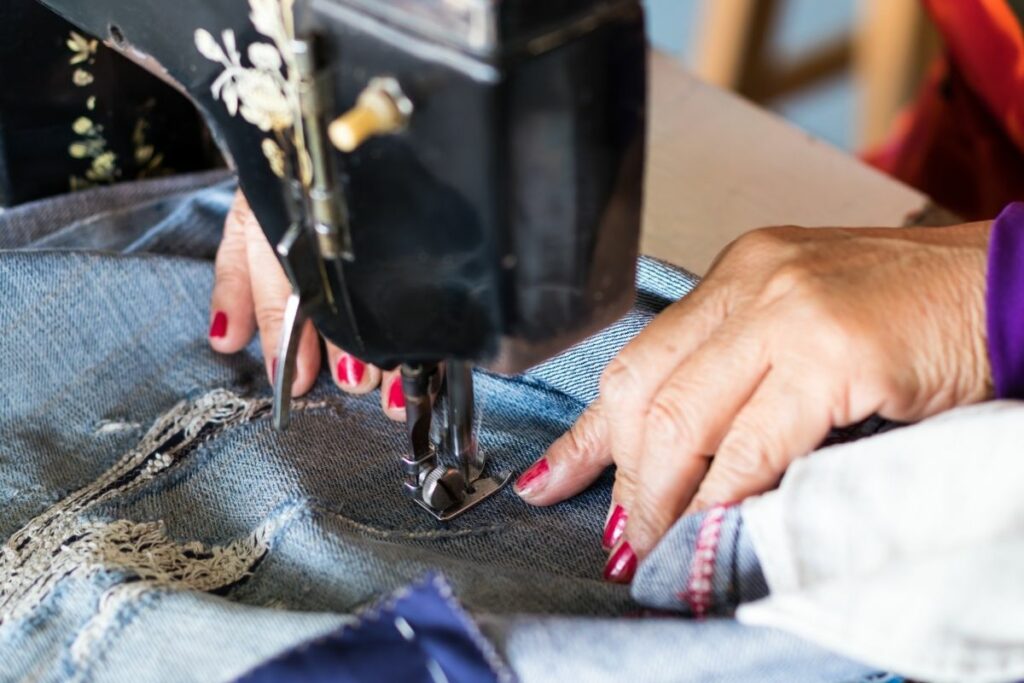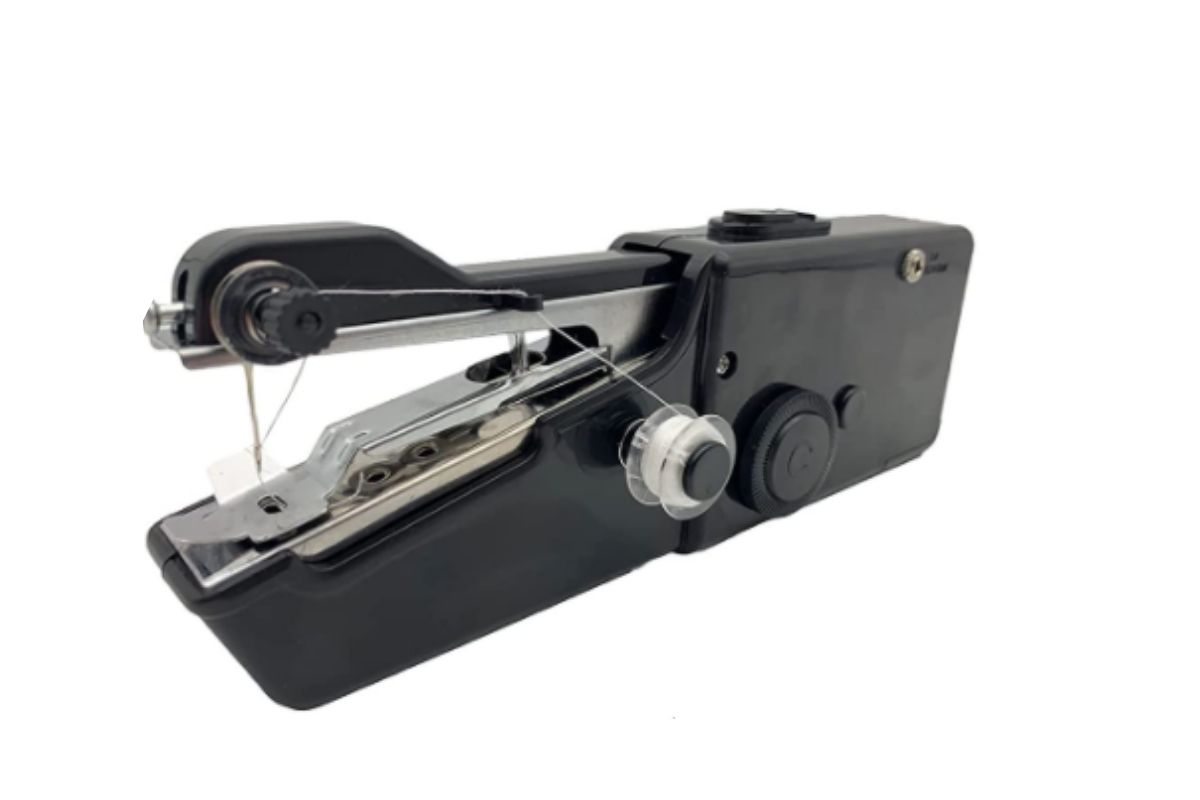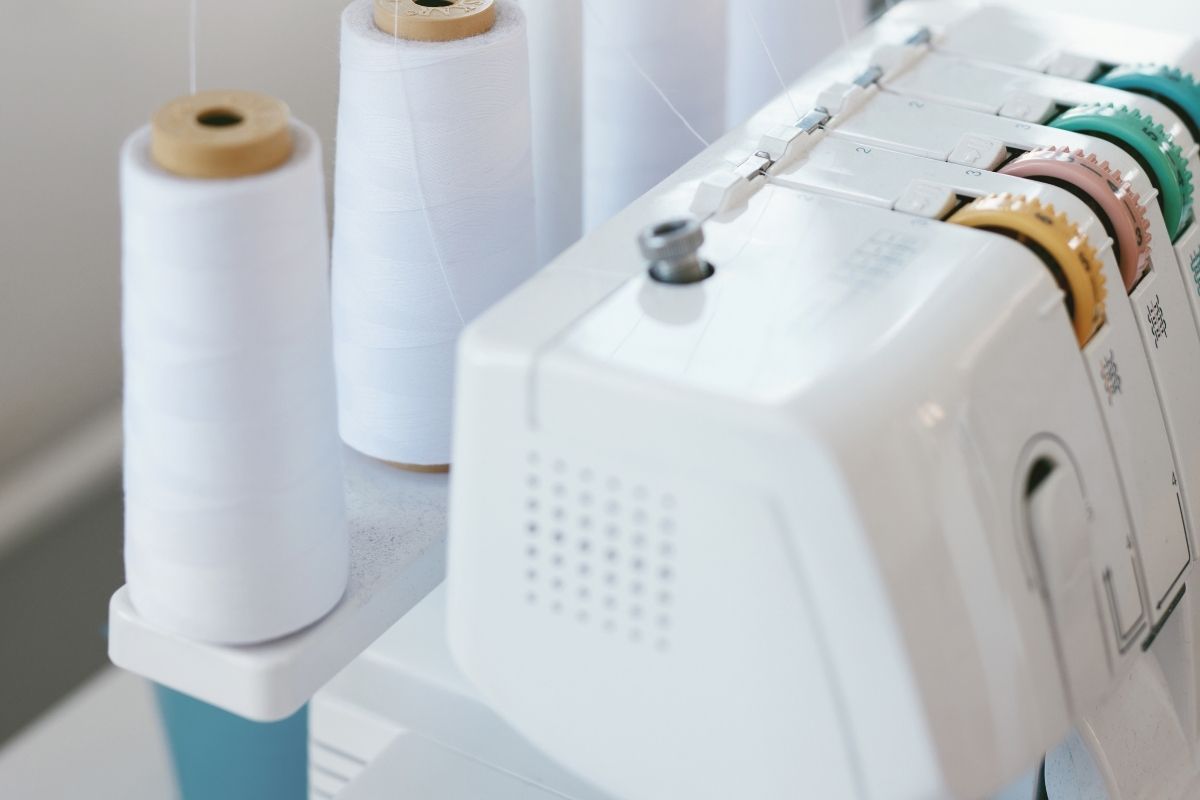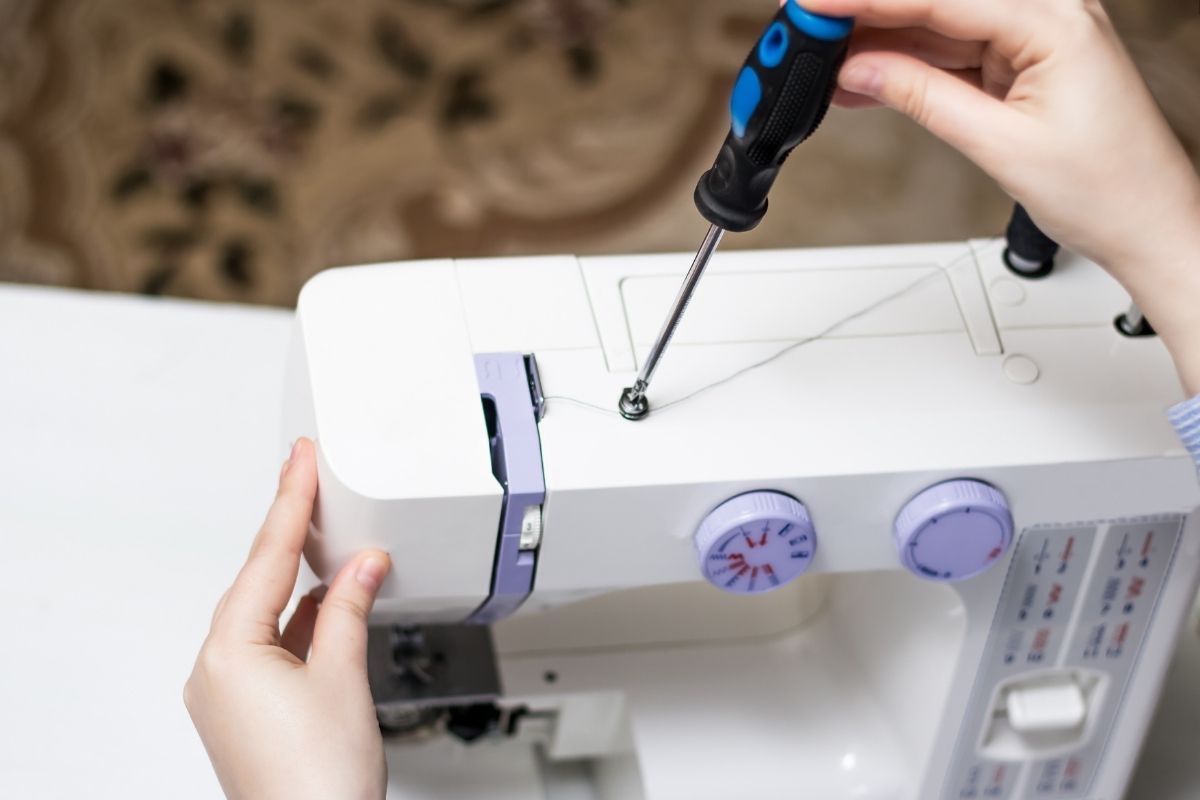We’ve all been there. Our favorite pair of jeans gets ripped, and we don’t know what to do. Do you throw them away or do you try to fix them? You don’t know if you will find a new pair that fits you perfectly as these did. If you decide to try to fix them, you should know how to do so. How do you repair jeans?
There are many ways you can repair jeans. Some easier methods are using fabric glue or fabric patches. The most durable method for fixing your ripped jeans is sewing.

It doesn’t matter if you know how to sew, as there are many methods for fixing jeans. Each method of repairing your jeans offers you a different look.
How do you fix ripped jeans without sewing?
If you don’t know how to sew or don’t have a sewing machine, don’t worry, you can still fix your jeans.
To fix your jeans, you can use a fabric patch. You can choose between the ones that are the same color as your jeans, or you can pick a decorative fabric patch.
Another way to fix your jeans without sewing is by using fabric glue. Be mindful of which glue you will buy to fix your jeans, as there are many different types.
These two methods are not very durable, as the glue will probably wear off after a few washes.
For something more permanent, you can embrace the ripped look. If your jeans are ripped on the front side that is a great opportunity to transform the look of your jeans. Ripped jeans are very popular nowadays and you can find them in any clothing store. They are often even more expensive than normal jeans.
To make your jeans go from ruined to ripped, you will need a pair of scissors and some sandpaper, and a flat surface. If you don’t have sandpaper, you can use a cheese grater.
Begin by placing your jeans on a flat surface, ideally a table. Next, depending on where the hole or tear on your jeans is, take a small object and place it inside the jeans in that area to prevent you from accidentally ripping both sides of the jeans.
Take the sandpaper or cheese grater, and start to soften up the area surrounding the tear or hole in your jeans. This technique will allow you to pull off the frayed look, but if you just would rather extend the hole or tear and go for the simple, ripped look then you can just do that instead.
Take the scissors, and start to pull away at loose fibers in the jeans in the area you just went over. At this point, you’ll start to see the look come into place. Take the threads once they appear visible and get creative by pulling them in different directions. Make sure to pull out more threads if you want a larger hole, and less if you’re looking for a more subtle effect.
You can also turn your torn jeans into shorts. This method only works if the tear is on the leg part of the jeans.
To transform your jeans into shorts, you will need a measuring tape, a fabric marker, and a good pair of scissors. Decide how short you want them to be.
Once you’ve decided, use the fabric marker to mark out the spot you want to cut up to. You’ll want an extra few inches beyond that if you decide to mess around with frayed edges etc.
Next, simply cut where you made the marks. This can be the end of the transformations, or you can modify them a bit more.
If you’re looking for the frayed edge look for your new jean shorts, you will again use sandpaper or cheese grater to soften up the threads, and then take out the threads.
If you like the roll-up look, then once you have finished cutting the jeans to the appropriate length, roll up each leg and switch these rolls at the side to keep them there.
Can you use fabric glue on jeans?
The simplest way of repairing jeans is probably using fabric glue. If you have wondered whether you can use fabric glue on your jeans, the answer is yes.
When using fabric glue to fix your jeans, you will also need a patch made out of denim that looks similar to your jeans. You don’t want the patch to be too visible.
Make sure you follow the directions on the glue because you need to have a proper amount of glue both on the patch and on the jeans to fix them.
To successfully repair your jeans with glue, you have to pick the right one. You want to get a fabric glue that is permanent and waterproof. Buy a fabric glue that comes in a tube or a bottle with a little needle nose, as they prevent making a mess and help you be precise. Make sure that the glue is transparent.
Get a liquid fabric glue, and put only a thin layer of it because fabric glue can make denim a bit stiff.
Once you apply the glue, let it dry for long enough before you wear your clothes again. Don’t wash them right away, give the glue a good opportunity to adhere to the fibers.
Keep in mind that you have to clean your jeans before you glue them because the glue won’t work if your jeans are dirty.
To make sure that you don’t glue together anything that you’re not supposed to, turn your jeans inside out and place a piece of cardboard between the rip and the other side of the jeans.
It is possible that you accidentally drop some glue on the wrong part of the jeans. If the jeans are white, you can try to get the glue off them with a nail polish remover. Another way to get it off is with steam heat, but that takes more time. You can try mixing 2 parts of baking soda and one part coconut oil. Spread it on with a toothbrush on the affected area and rinse with liquid laundry soap. Wash them.
Can you repair jeans with fabric?
The second easiest way to repair your jeans is with fabric. You can buy denim-colored patches in stores. They are very convenient because they have an adhesive in the back of them. You can repair your jeans by simply keeping the patch on top of the hole and ironing over them.
The biggest drawback of using fabric patches to repair your jeans is that it is not a permanent solution. The adhesive will wear off after a few washes. Another drawback is that it will be obvious that your jeans were repaired.
To repair your jeans with a fabric patch, keep the patch face up over the hole so that the patch is overlapping at least 1/4 inch all around the hole. Iron over them, using the correct heat for denim, and use some pressure to fix it properly.
Can you patch jeans on the inside?
If you were wondering whether you can patch your jeans from the inside, the answer is yes. Depending on which method you decide to use, you will be needing some thread that matches your jeans, fusible, scissors, a swatch of spare denim, a sewing machine, and an ironing board and iron.
If the rip in your jeans is small, an iron patch is the easiest solution. Since you’re using scrap denim and fusible, you’ll attach the patch from the inside of your jeans.
For narrow rips, you can do some sewing repair by hand. You will have to have minimal sewing skills to do this. A blind stitch is recommended because it makes the hole disappear and the stitches harder to see when you’re finished.
Start by cutting away any of the frayed parts but not the fabric. Start 1/2 inch from the right edge of the hole by threading your needle from the inside of the jeans to the top. Make vertical stitches and slowly make them bigger until they’re the height of the hole. Pull the thread and make it taught to make it invisible.
If you have some more sewing skills, you can use a sewing machine to repair your jeans from the inside.
How to fix torn jeans?
The best, most durable, and the most permanent method of fixing torn jeans is with a sewing machine.
For this method, find a woven fabric that is of about the same weight as the denim of your jeans or find a denim scrap in the same color. Try to find a fabric in the same color as your jeans.
Step 1: Tidy up the hole in your jeans by cutting out the projecting thread from the hole. They do not help by being there as you repair the hole.
Another thing you can do is to turn under the torn edges to the back, this way those threads would not be visible.
Step 2: Turn your jeans inside out and keep the patch you have cut up face down on the hole.
Step 3: Fix it. You have many options, you can just baste stitch it there or just do running stitches loosely to attach the patch, and do it around the edge of the patch, as these stitches will later be taken out. Or you can use a fusible, a thin webbing that can be used to glue two fabrics together when heated with an iron or you can use the glue stick to adhere the patch, to fix it.
Step 4: Turn the jeans right side out. You will be stitching from the face of the jeans.
Step 5: Make sure to thread your sewing machine with a thread that closely resembles the color of the jean.
Step 6: Keep the jeans under your sewing machine, and using your free arm conveniently move the jeans as you stitch. You can use the straight stitch or the zig-zag stitch.
Step 7: Remember to make those stitches in the direction the original fabric is woven. Denim has a twill type of fabric weave made diagonally.
How do you fix ripped jeans between your legs?
To fix jeans that have been ripped between your legs, you will need a darning or embroidery foot, high-quality cotton interfacing, and a few thread colors to match your denim.
When you use a darning foot is it easier to see what you’re doing, but in a pinch, you can try using a straight stitch foot as well. The high-quality cotton interfacing helps stabilize and strengthen the weakened area, and the multiple thread colors will let you match the original color of the denim along with any fading.
Denim only has two directions, which are the vertical thread, also known as warp, and a diagonal thread, also known as weft. Since you are probably mending a horizontal rip you want to first work in the warp threads and then weave in some diagonal threads to finish. If this is all very new to you, hold your repair up to the light in order to see which threads are missing and this will help you wrap your head around the task. It will also tell you how big you want to make your interfacing patch as you want to extend your mending at least as far as the thinning of the fabric goes. Otherwise, you will be chasing your tear sooner rather than later.
Cut your interfacing. You want to make sure the piece is big enough that you can extend your stitching out past the hole. Iron it on while using a high-heat iron and no steam. Press it for at least 20 seconds.
Load your bobbin with a mid-range color and the top with the “middle” color of your denim. Make sure to take a little time to try some stitching on a scrap piece and get yourself familiarized with the free-form back and forth stitching. Stitch up and down and from left to right using the grainline as your guide. At this stage, you want to avoid moving too much diagonally. Imagine you are replacing the missing or broken threads and make sure you continue well above and below your hole to blend things as much as possible.
Every few minutes take your work to a window to see how things are going. In case that you’re repairing stretch denim, you’ll notice the stitching can distort the fabric since you are essentially making stretch denim into non-stretch with your stitching.
Keep in mind that it is really easy to get carried away and this method requires a less is more approach. It is also really hard to pick this work out so it’s better to stop and see if you need more than regret it later.
Once you’re happy with how your first layer turned out, you can choose a darker or lighter shade to work in the diagonal. Lay a strand or two over the work to get a sense of the effect.
Since the tear is on or near a seam you should try overlapping your stitching onto the seam without touching the topstitching. If there is any wear along the seam, you could end up creating a new hole once you’re done. In case that the tear is very bad, open up the seam, darn the area and then re-sew the seam and replace the topstitching.
While working on the slightly darker color on the diagonal, give your jeans a press with some steam which helps to integrate the threads, and also snap back the stretch denim that had started to pucker.
Source
- https://www.thecreativefolk.com/patch-pants-inside/
- https://www.manmadediy.com/2651-the-diy-tailor-an-easy-way-to-fix-holes-in-your-jeans-and-other-garments
- https://www.gq.com/story/the-best-way-to-fix-your-ripped-jeans
- www.weallsew.com/jeans-tips/
Related posts
-
Handheld sewing machine

You can always feel a great sense of accomplishment when you have finished output with your hands. The feeling of elation is such a great emotion knowing that you have accomplished something out from scratch. There is always a strong feeling of joy when you have something to show yourself and your friends that you…
-
Serger vs Sewing Machine

Ever wondered what would be the next step in building your sewing skills? Imagining those amazing, professional-looking stitches and knits, but don’t have the prowess to do it with a conventional sewing machine? It may not be common for casual seamstress or tailors, but a serger is one great tool in achieving those clean seams,…
-
Sewing machine repair

Patching, fixing, and sewing tattered clothing is a tiresome and yet rewarding task. Having the idea that you have accomplished something is a great feeling and making it last is a challenge. Sewing will demand time, patience, dedication, and hard work. Your tool of choice is obviously your good old and dependable as ever sewing…


